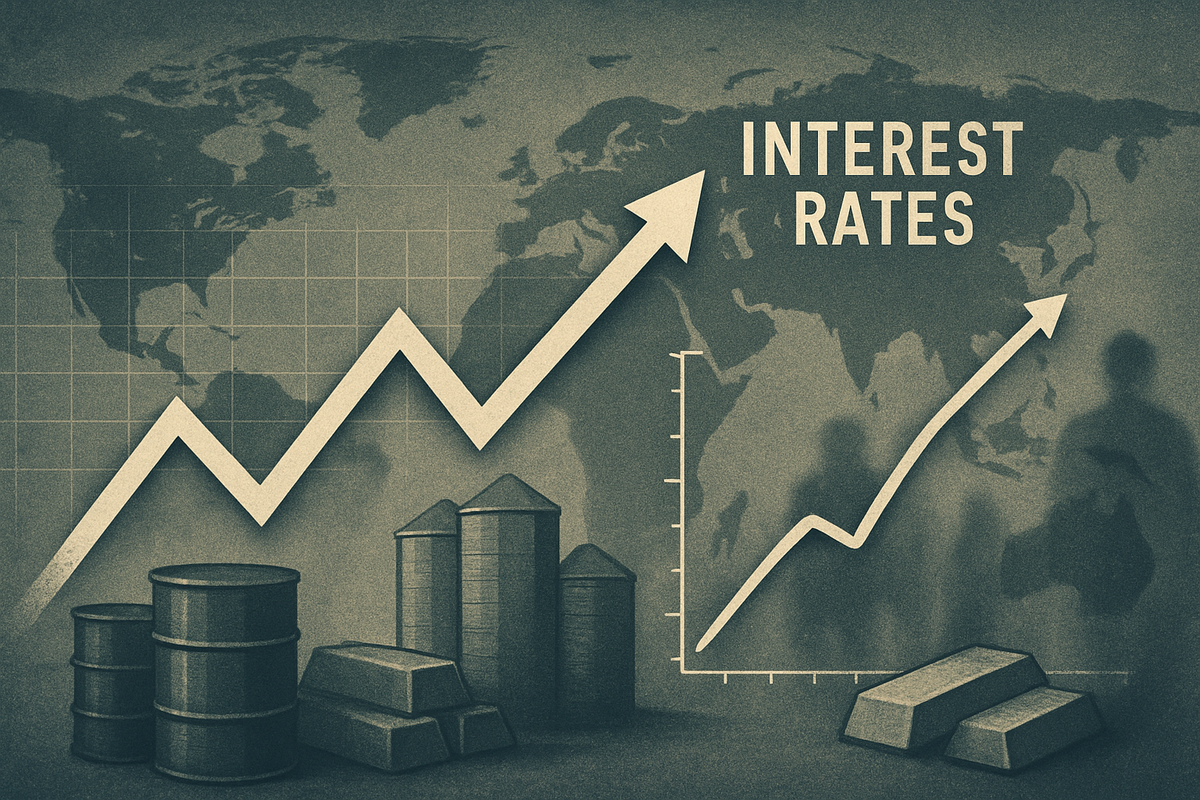
As November 2025 unfolds, the global financial landscape remains under the persistent shadow of elevated inflation and a complex, albeit moderating, interest rate environment. This intricate economic backdrop is casting a pall over global markets, leading to pronounced investor volatility and significantly impacting commodity prices. While some regions show signs of inflation cooling, the underlying pressures and the nuanced approaches of central banks worldwide are creating a challenging period for both developed and emerging economies, prompting caution among market participants.
The immediate implications are palpable: a "limping" global economy navigating geopolitical tensions and policy fragmentation. Investors are grappling with uncertainty, reflected in fluctuating equity markets, shifting bond yields, and a strengthening US dollar. The path forward remains murky, as central banks weigh the delicate balance between taming inflation and supporting economic growth, leaving markets susceptible to sudden shifts in sentiment and policy expectations.
The Enduring Economic Headwinds: A Closer Look
The current economic climate is defined by inflation's stubborn grip and central banks' efforts to recalibrate monetary policy. As of November 2025, global headline inflation is projected to decline to 4.4% for the year, a modest improvement, yet the journey to the coveted 2% target is proving arduous and uneven across major economies. In the United States, the Consumer Price Index (CPI) recently accelerated to an annual rate of 2.9% in October 2025, primarily driven by persistent pressures in housing and services. Core Personal Consumption Expenditures (PCE) inflation was anticipated to climb to 4.6% (quarterly annualized) in Q3 2025, with a year-end projection of 3.4%, indicating that underlying price pressures remain a significant concern for the Federal Reserve.
Across the Atlantic, the Euro Area anticipates a continued decline in inflation, expected to reach 2.1% in 2025, gradually aligning with the European Central Bank's (ECB) 2% target. Similarly, the United Kingdom saw inflation at 3.8% in September 2025, having peaked earlier in the year, with the Bank of England (BoE) believing it will fall towards 2% over the next year. This regional divergence highlights the varied economic realities and policy responses. Central banks, the key players in this scenario, are navigating a tightrope walk. The Federal Reserve's projected interest rate stands at 3.74% as of mid-November 2025, with market-implied probabilities of a December rate cut significantly decreasing due to renewed inflation concerns. In contrast, the Bank of England cut its interest rate to 4% in August 2025 and is expected to ease further in December, signaling a more dovish stance influenced by labor market concerns and a belief that inflation has peaked. The European Central Bank's projected rate is 1.92%, while other central banks like the Reserve Bank of Australia (RBA) at 3.57% and the Bank of Canada (BoC) at 2.26% are also adjusting their policies.
Initial market reactions have been characterized by heightened volatility. Global stock indices have experienced declines, particularly in the euro area, and the Cboe Volatility Index (VIX) has risen significantly, reflecting increased market nervousness. While US equity investor sentiment saw some improvement in early November, fueled by easing macroeconomic concerns and optimism surrounding the AI cycle in the information technology sector, this has been tempered by concerns over high valuations and uncertainty regarding future Fed rate cuts, leading to "risk-off" sessions and stock sell-offs. Sovereign bond yields have generally risen in the US and Europe, though US Treasuries have seen demand during periods of deteriorating risk sentiment. The US dollar has strengthened amid risk-averse sentiment, while pro-cyclical currencies have weakened, illustrating the flight to safety dynamics currently at play. This complex interplay of inflation, interest rates, and market sentiment paints a picture of a global economy striving for stability amidst persistent challenges.
Companies Navigating the Crosscurrents: Winners and Losers
The prevailing environment of persistent inflation and high interest rates creates a distinct bifurcation in corporate performance, with certain sectors and companies poised to either thrive or struggle. Companies with strong pricing power and robust balance sheets are better positioned to absorb increased input costs and higher borrowing expenses. For instance, large-cap technology firms (NASDAQ: MSFT, NASDAQ: AAPL, NASDAQ: GOOGL) with dominant market positions and high-margin software or service offerings often possess the ability to pass on costs to consumers without significant demand erosion. Furthermore, the ongoing Artificial Intelligence (AI) cycle continues to fuel optimism in the information technology sector, providing a growth narrative that can partially offset broader economic headwinds. Companies deeply entrenched in this cycle, such as NVIDIA Corporation (NASDAQ: NVDA) or Advanced Micro Devices (NASDAQ: AMD), might see continued demand for their specialized hardware and software, even as borrowing costs rise for their clients.
Conversely, companies with high debt loads, thin margins, or those heavily reliant on consumer discretionary spending are likely to face significant headwinds. Smaller businesses and startups often struggle with access to affordable capital, making expansion and even day-to-day operations more challenging when interest rates are elevated. Sectors like residential construction and automotive (NYSE: GM, NYSE: F) are particularly vulnerable to higher mortgage and auto loan rates, which dampen consumer demand for big-ticket items. Companies in these sectors, especially those with significant capital expenditure requirements or inventory financing needs, could see their profitability squeezed. Furthermore, consumer discretionary retailers (NYSE: AMZN, NYSE: WMT) might experience reduced sales volumes as inflation eroding purchasing power and consumers prioritize essential goods over non-essential ones.
The impact on commodity prices also creates winners and losers. While the prompt mentions commodity prices are impacted, the specific direction is crucial. If inflation continues to drive up commodity prices (e.g., energy, certain raw materials), companies involved in extraction and production (NYSE: XOM, NYSE: CVX for oil and gas; NYSE: FCX for copper) could see increased revenues, assuming demand remains resilient. However, companies that are net consumers of commodities across various industries, from manufacturing to food production, will face higher input costs, which, if not effectively managed or passed on, will compress profit margins. The intricate dance between inflation, interest rates, and commodity markets means that companies with agile supply chains, efficient cost management, and diversified revenue streams are best equipped to navigate these turbulent waters, while those with less flexibility may find themselves struggling to maintain profitability and market share.
Wider Significance: Reshaping the Global Economic Fabric
The prolonged battle against inflation and the sustained period of high interest rates are not merely transient market events; they are fundamentally reshaping the global economic fabric, with far-reaching implications that extend beyond immediate market reactions. This environment fits into a broader trend of deglobalization and supply chain re-evaluation, accelerated by recent geopolitical tensions. The focus on "reshoring" or "friend-shoring" production, while potentially increasing supply chain resilience, often comes at a higher cost, contributing to persistent inflationary pressures even as demand moderates. The current scenario underscores the shift from a decade of ultra-low interest rates and quantitative easing to a more restrictive monetary policy stance, a significant pivot for central banks worldwide.
The ripple effects on competitors and partners are substantial. Companies with strong balance sheets and access to cheaper financing can acquire struggling competitors or invest in new technologies, consolidating market power. Conversely, partners in supply chains, particularly smaller businesses, may face increased financing costs, leading to disruptions or even failures, which can then cascade through larger ecosystems. Regulatory and policy implications are also emerging. Governments are under pressure to provide fiscal relief to citizens grappling with higher living costs, potentially leading to increased public debt. There's also a growing debate about the appropriate level of central bank independence and the tools available to combat inflation without stifling economic growth. Some policymakers might advocate for targeted industrial policies to bolster domestic production and reduce reliance on volatile global supply chains.
Historically, periods of persistent inflation and high interest rates, such as the late 1970s and early 1980s, offer valuable, albeit not perfectly analogous, precedents. During those times, aggressive monetary tightening by central banks, notably the Federal Reserve under Paul Volcker, eventually brought inflation under control but at the cost of significant economic slowdowns and recessions. While today's economic structure differs in terms of globalization, technology, and labor market dynamics, the core challenge remains: how to deflate price pressures without triggering a severe downturn. The current environment also highlights the increasing fragmentation of global economic policy, with different central banks pursuing divergent paths based on their domestic economic conditions, potentially leading to currency volatility and trade imbalances. This complex interplay of trends, policies, and historical lessons suggests that the current economic challenges are systemic and will likely necessitate adaptive strategies from businesses, governments, and investors alike.
What Comes Next: Navigating the Uncertain Path Ahead
The coming months and years will be crucial in determining the long-term trajectory of the global economy amidst persistent inflation and elevated interest rates. In the short term, markets will remain highly sensitive to incoming economic data, particularly inflation reports and central bank communications. Any signs of inflation re-accelerating could prompt further hawkish rhetoric from central banks, leading to increased market volatility and potential further rate hikes in some regions. Conversely, a clearer trend of disinflation, coupled with signs of economic softening, could pave the way for more significant interest rate cuts, potentially boosting equity markets. Investors should brace for continued swings as central banks finely tune their policies, reacting to evolving economic conditions. The market-implied probability of Fed rate cuts, for instance, has already seen significant shifts, underscoring the dynamic nature of expectations.
For businesses, strategic pivots and adaptations will be paramount. Companies will need to focus on enhancing operational efficiency, optimizing supply chains to mitigate inflationary pressures, and carefully managing debt loads. Innovation, particularly in areas like automation and artificial intelligence, could offer avenues for cost reduction and productivity gains, providing a competitive edge. Market opportunities may emerge in sectors that are traditionally resilient during economic downturns, such as utilities, healthcare (NYSE: JNJ, NYSE: PFE), and certain consumer staples (NYSE: PG, NYSE: KO), which tend to offer more stable demand. Additionally, companies with strong cash flows and undervalued assets might become attractive acquisition targets.
Looking further ahead, several potential scenarios and outcomes could unfold. One scenario involves a "soft landing," where inflation gradually recedes without triggering a deep recession, allowing central banks to ease monetary policy in a controlled manner. This would likely lead to a more stable and potentially growth-oriented market environment. Another possibility is a more prolonged period of "stagflation," characterized by persistent inflation alongside sluggish economic growth, which would present significant challenges for both businesses and investors. Finally, a "hard landing" scenario, involving a deeper recession, could occur if central bank tightening proves too aggressive or if external shocks materialize. Investors should closely monitor geopolitical developments, commodity price movements, and the labor market, as these factors will be key determinants of the economic path forward and will necessitate agile portfolio adjustments.
Comprehensive Wrap-up: A New Era of Financial Prudence
The current era of persistent inflation and high interest rates marks a significant departure from the accommodative monetary policies of the past decade, ushering in a new paradigm for global financial markets. The key takeaway is the pervasive uncertainty and the need for heightened financial prudence. While inflation shows signs of moderating in some regions, its stickiness in core components, particularly in the US, means that central banks are unlikely to revert to ultra-low rates anytime soon. This sustained higher cost of capital will continue to influence corporate investment decisions, consumer spending, and government fiscal policies.
Moving forward, the market will likely remain characterized by increased volatility and a greater emphasis on fundamental value. Companies with strong balance sheets, sustainable business models, and the ability to adapt to changing cost structures will be better positioned to weather the storm. Investors should prioritize diversification, focus on long-term investment horizons, and be prepared for continued fluctuations in asset prices. The days of easy money and rapidly inflating asset bubbles appear to be behind us, at least for the foreseeable future.
What investors should watch for in the coming months includes the trajectory of core inflation metrics, the employment data, and, crucially, the forward guidance from major central banks regarding their monetary policy intentions. Any unexpected shifts in these indicators could trigger significant market reactions. Geopolitical stability and the resolution of ongoing supply chain issues will also play a critical role in shaping the economic outlook. Ultimately, this period demands a cautious yet adaptable approach, as the global economy navigates a complex transition towards a potentially more disciplined and fundamentally driven financial environment.
This content is intended for informational purposes only and is not financial advice




